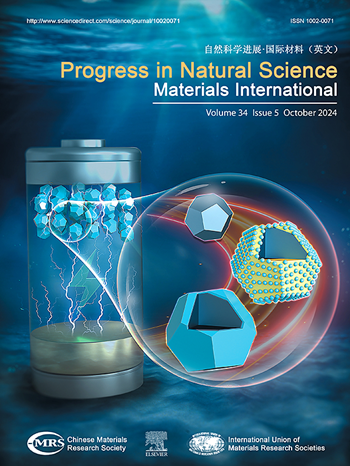Mechanical property enhancement of basalt fiber-reinforced epoxy composites via construction of an organic/inorganic hybrid interface
IF 7.1
2区 材料科学
Q2 MATERIALS SCIENCE, MULTIDISCIPLINARY
Progress in Natural Science: Materials International
Pub Date : 2025-04-01
DOI:10.1016/j.pnsc.2025.01.002
引用次数: 0
Abstract
Basalt fiber (BF) reinforced polymer composites (BFRPs) have promising applications in aerospace, chemical, automotive, and other advanced technologies. However, their mechanical properties are currently limited due to poor interfacial bonding between the smooth, inert, and low-energy surfaces of BF and the polymer matrix. To address this issue, in the present study, polydopamine (PDA) and polyethyleneimine (PEI) are grown in-situ on the BF surface and followed by grafting of carboxylic-functionalized, multi-walled carbon nanotubes (C-CNTs) on the PDA/PEI layer to construct an organic/inorganic hybrid interface between the fiber and polymer matrix (epoxy resin). Mechanical characterization of the resulting BF-PDA/PEI-C-CNTs/epoxy composites exhibit a 64.7 %, 34.4 %, 27.5 %, and 28.9 % increase in the interfacial shear strength (IFSS), interlaminar shear strength, flexural strength, and tensile strength of the modified BFRPs respectively. In addition, surface analysis of the modified BF shows an increase in surface roughness (Ra) from 9.80 nm to 43.46 nm. Finite element analysis (FEA) indicates that the maximum internal stress in the composite decreases with increasing thickness of the interfacial transition zone after BF modification, reaching a maximum reduction of 59.8 %. Overall, this construction of a hybrid interface between the two phases of the composite provides a simple, effective, and promising strategy to improve the mechanical performance of BFRPs.
通过构建有机/无机杂化界面增强玄武岩纤维增强环氧复合材料的力学性能
玄武岩纤维(BF)增强聚合物复合材料(BFRPs)在航空航天、化工、汽车等先进技术领域有着广阔的应用前景。然而,由于BF的光滑、惰性和低能表面与聚合物基体之间的界面结合不良,它们的机械性能目前受到限制。为了解决这一问题,本研究在BF表面原位生长聚多巴胺(PDA)和聚乙烯亚胺(PEI),然后在PDA/PEI层上接枝羧基功能化的多壁碳纳米管(C-CNTs),构建纤维与聚合物基体(环氧树脂)之间的有机/无机杂化界面。结果表明,改性后的BF-PDA/PEI-C-CNTs/环氧复合材料的界面剪切强度(IFSS)、层间剪切强度、抗弯强度和抗拉强度分别提高了64.7%、34.4%、27.5%和28.9%。此外,表面分析表明,改性BF的表面粗糙度(Ra)从9.80 nm增加到43.46 nm。有限元分析(FEA)表明,BF改性后,复合材料的最大内应力随界面过渡区厚度的增加而减小,最大减小幅度为59.8%。总的来说,在复合材料的两相之间构建混合界面为提高bfrp的力学性能提供了一种简单、有效和有前途的策略。
本文章由计算机程序翻译,如有差异,请以英文原文为准。
求助全文
约1分钟内获得全文
求助全文
来源期刊
CiteScore
8.60
自引率
2.10%
发文量
2812
审稿时长
49 days
期刊介绍:
Progress in Natural Science: Materials International provides scientists and engineers throughout the world with a central vehicle for the exchange and dissemination of basic theoretical studies and applied research of advanced materials. The emphasis is placed on original research, both analytical and experimental, which is of permanent interest to engineers and scientists, covering all aspects of new materials and technologies, such as, energy and environmental materials; advanced structural materials; advanced transportation materials, functional and electronic materials; nano-scale and amorphous materials; health and biological materials; materials modeling and simulation; materials characterization; and so on. The latest research achievements and innovative papers in basic theoretical studies and applied research of material science will be carefully selected and promptly reported. Thus, the aim of this Journal is to serve the global materials science and technology community with the latest research findings.
As a service to readers, an international bibliography of recent publications in advanced materials is published bimonthly.

 求助内容:
求助内容: 应助结果提醒方式:
应助结果提醒方式:


